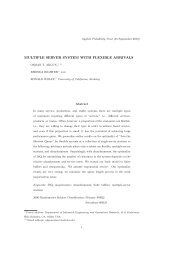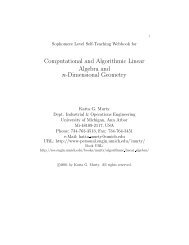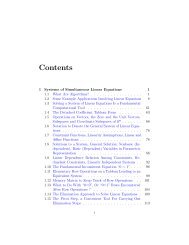Chapter 1 LINEAR COMPLEMENTARITY PROBLEM, ITS ...
Chapter 1 LINEAR COMPLEMENTARITY PROBLEM, ITS ...
Chapter 1 LINEAR COMPLEMENTARITY PROBLEM, ITS ...
You also want an ePaper? Increase the reach of your titles
YUMPU automatically turns print PDFs into web optimized ePapers that Google loves.
2 <strong>Chapter</strong> 1. Linear Complementarity Problem, Its Geometry, and Applications<br />
The only data in the problem is the column vector q and the square matrix M. So we<br />
will denote the LCP of nding w 2 R n , z 2 R n satisfying (1.1) by the symbol (q M).<br />
It is said to be an LCP of order n. 8In<br />
an9LCP of8order n there are 2n variables. As<br />
a speci c example, let n =2,M = >: 2 1>,<br />
q = >:<br />
1 2<br />
;5<br />
9<br />
>. This leads to the LCP<br />
;6<br />
w1 ; 2z1; z2 = ;5<br />
w2 ; z1;2z2 = ;6:<br />
w1w2z1z2 > = 0 and w1z1 = w2z2 =0:<br />
The problem (1.2) can be expressed in the form of a vector equation as<br />
w1<br />
8<br />
9<br />
8<br />
9<br />
8<br />
9<br />
(1:2)<br />
>: 1><br />
+ >: w2<br />
0<br />
0><br />
+ >: z1<br />
1<br />
;2><br />
+ >: z2<br />
;1<br />
;1><br />
= >:<br />
;2<br />
;5><br />
;6<br />
(1:3)<br />
w1w2z1z2 > = 0 and w1z1 = w2z2 =0 (1:4)<br />
In any solution satisfying (1.4), at least one of the variables in each pair (wjzj),<br />
has to equal zero. One approach for solving this problem is to pick one variable from<br />
each of the pairs (w1z1), (w2z2) and to x them at zero value in (1.3). The remaining<br />
variables in the system may be called usable variables. After eliminating the zero<br />
variables from (1.3), if the remaining system has a solution in which the usable variables<br />
are nonnegative, that would provide a solution to (1.3) and (1.4).<br />
Pick w1, w2 as the zero-valued variables. After setting w1, w2 equal to 0 in (1.3),<br />
the remaining system is<br />
-2 () -1<br />
z1<br />
8<br />
9<br />
8<br />
9<br />
8<br />
8<br />
>: ;2><br />
+ >: z2<br />
;1<br />
;1><br />
= >:<br />
;2<br />
;5><br />
=<br />
;6<br />
-1 ( -2)<br />
q<br />
2<br />
z1 > = 0 z2 > = 0<br />
q1<br />
9<br />
9<br />
8<br />
8<br />
>: q1<br />
9<br />
> = q<br />
q2<br />
9<br />
(1:5)<br />
Figure 1.1 A Complementary Cone<br />
Equation (1.5) has a solution i the vector q can be expressed as a nonnegative<br />
linear combination of the vectors (;2 ;1) T and (;1 ;2) T . The set of all nonnegative










